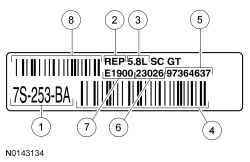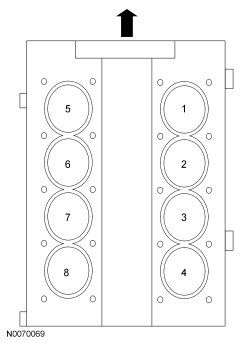SECTION 303-01C: Engine — 5.8L (4V)
| 2014 Mustang Workshop Manual
|
DESCRIPTION AND OPERATION
| Procedure revision date: 01/07/2013
|
The 5.8L (355 CID) is a V-8 engine with the following features:
Engine Identification
Always refer to these labels when installation of new parts is necessary or when checking engine calibrations. The engine parts often differ within a CID family. Verification of the identification codes will make sure that the correct parts are obtained. These codes contain all the pertinent information relating to the dates, optional equipment and revisions. The Ford Master Parts Catalog contains a complete listing of the codes and their applications.
Engine Code Information Label
The engine code information label, located on the front side of the valve cover, contains the following:

| Item | Description |
|---|---|
| 1 | Engine part number |
| 2 | Romeo engine plant |
| 3 | Engine displacement |
| 4 | Bar code |
| 5 | Running number |
| 6 | Engine build date (DDMMYY) |
| 7 | Plant shift line |
| 8 | Bar code |
Engine Cylinder Identification

Supercharger (SC)
NOTE: Some Mustang Shelby GT500 vehicles may exhibit a SC belt squeal during 1st to 2nd gear shift under hard acceleration. This is due to the transmission being shifted faster than the SC drive belt system can respond. This is a normal characteristic of this vehicle under this driving condition.
The SC is a positive displacement pump. Its purpose is to supply an excess volume of intake air to the engine by increasing air pressure and density in the intake manifold. The SC is matched to the engine by its displacement and belt ratio, and can provide excess airflow at any engine speed.
NOTE: The SC is repaired only as an assembly. Disassembly of the SC unit may void the warranty.
NOTE: The SC is not a bolt-on option. It is part of an integrated engine system. Many components of the supercharged engine are not interchangeable with similar parts from a non-supercharged engine.
The SC contains two 4-lobed rotors. The helical shape and specialized porting provide a smooth discharge flow and low level of noise during operation. The rotors are supported by ball bearings in front and needle bearings at the rear. The drive gears are pressed into place, therefore the SC is installed new as a unit, and is not repairable.
The SC system is a blow-through type with the fuel injected directly into the intake ports. The SC is belt driven off the crankshaft through an idler pulley. The throttle body controls the amount of intake air to the SC through the intake plenum. Air from the SC is routed through the CAC , then to the intake manifold. The resulting denser air charge in the combustion chamber provides for a higher power output of the engine over a non-supercharged engine of the same displacement.
NOTE: It is not possible to increase manifold pressure or engine power output by altering the bypass valve or the actuator.
At partial-throttle opening or when vacuum is present in the intake system, a vacuum controlled bypass valve reroutes some discharged air from the SC back through the intake plenum. This prevents the SC from cavitating, causing reduced performance, increased temperatures and poor economy.
The SC has a self-contained oiling system that does not require a fluid change for the life of the vehicle.
Induction System
The SFI provides the fuel/air mixture needed for combustion in the cylinders. The 8 solenoid-operated fuel injectors:
A constant fuel pressure drop is maintained across the fuel injectors by the fuel pressure regulator. The fuel pressure regulator:
Crankshaft
The crankshaft is supported on the bottom of the cylinder block by 5 crankshaft main bearings.
Camshafts
The camshafts:
Valve Train
The valves are actuated by a direct acting hydraulic lash adjuster and roller follower. The direct acting hydraulic lash adjusters and roller followers:
Engine Lubrication System
The engine lubrication system is of the force-feed type in which oil is supplied under full pressure to the:
All other parts are lubricated by splash of the oil.
Oil Pump
The lubrication system of the 5.8L (4V) engine is designed to provide optimum oil flow to critical components of the engine through its entire operating range. The heart of the system is a positive displacement internal gear oil pump using top seal rotors.
Generically, this design is known as a gerotor pump, which operates as follows: